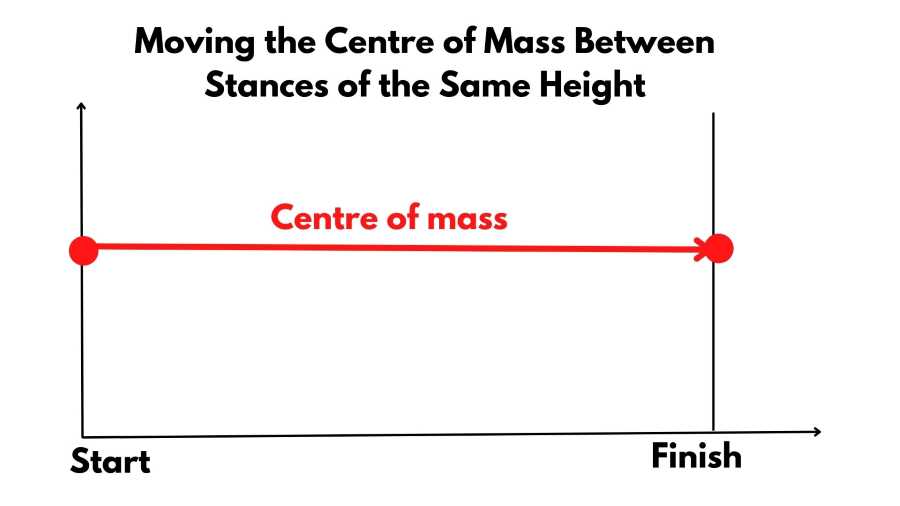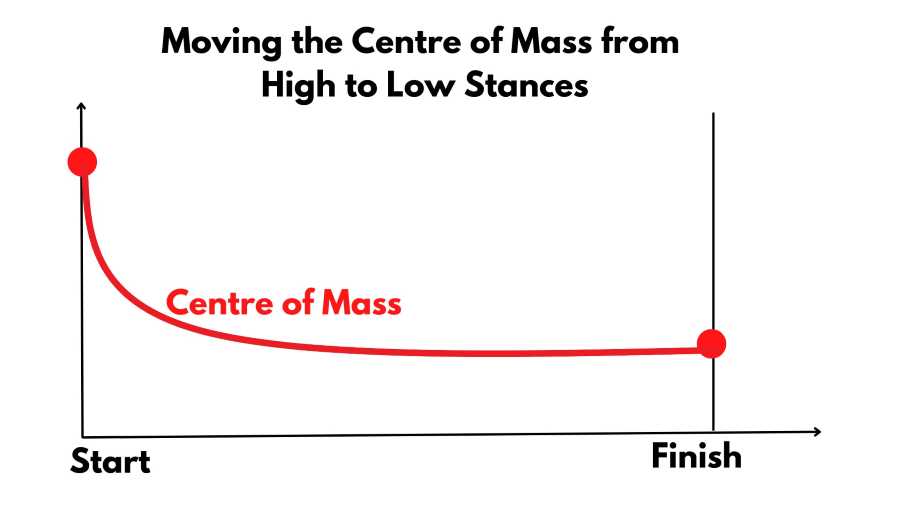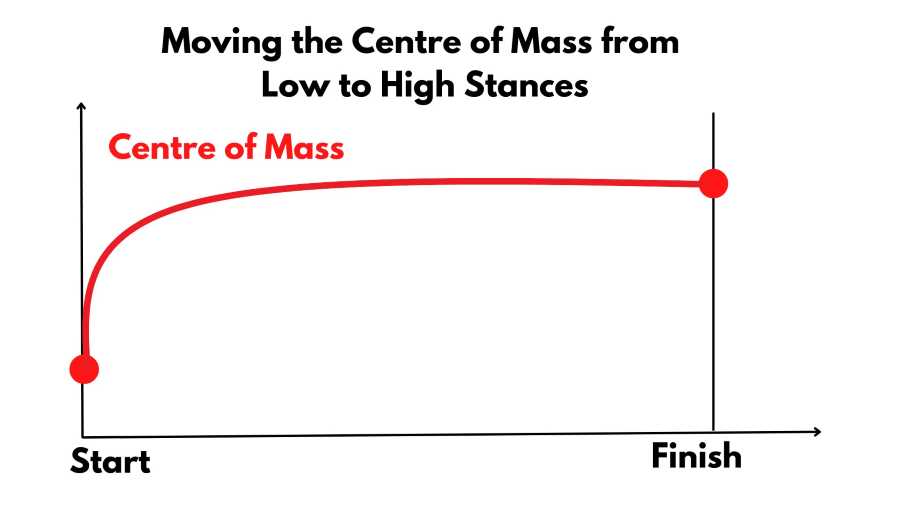This is the second post of the series covering valuable karate lessons and insights from the legendary karate instructor, Yoshimi Inoue.
Please check out the first post of the series if you haven’t already done so.
Table of Contents
- How to move your center of mass correctly
- Why basic karate blocks are double blocks
- Add pauses to your kata to improve its aesthetic aspect
- In kata competitions, don’t play safe, focus on speed
- Your karate techniques don’t start with your hands, they originate from your hips
- Kumite is based on two principles: distance and timing
How to move your center of mass correctly
1. When transitioning between stances of the same heights
When moving between stances of the same height, Inoue teaches that you need to move the center of mass horizontally across as shown in the graph below.

For example, if you move from a shiko dachi stance to another shiko dachi stance, think of moving your center of mass or your tandien along a horizontal line. That means, keep your centreline straight, your head at a constant height, and don’t go up and down.
Moving your center of mass along a straight line can help with stability and make your kata performance look visibly better.
When Rika Usami performed the first three sequences of the Seienchin kata which are all in the shiko dachi stance, she maintained her head height and moved her center of mass across horizontally.
2. When transitioning from high to low stances
When moving from a high stance to a low stance, the correct way of transitioning, according to Inoue, is to drop the center of mass first and then move it across horizontally.
Again, this makes sense because you can maintain your stability much easier when the center of mass travels on a straight line than when it travels diagonally.

For example, when you need to transition from a heiko sanchin stance to a shiko dachi stance, the correct way is to drop your tandien down and then move it across.
Also, when transitioning between techniques, always think about moving your tandien or the center of mass instead of focusing on moving your legs or arms.
3. When transitioning from low to high stances
When moving from a low stance to a high stance, following the sample principle, you should move the center of mass up first and then bring it across horizontally if needed.
For example, if you are in a shiko dachi after finishing a technique and the next technique needs to be done in a han zenkutsu dachi, your center of mass should go up vertically first.

Why basic karate blocks are double blocks
Inoue teaches that basic blocks like gedan barai, age uke, yoko uke, shuto uke, and mawashi uke should be double blocks, i.e. both hands should be used to improve their effectiveness.
Inoue demonstrates that single-hand blocks are weaker and may be ineffective in fending off an attack. But when both hands are used, the supporting hand can help catch and deflect the attack so the main blocking arm can finish the job off.
In my opinion, Inoue had incredible speed and he could have intercepted attacks effectively with a single arm. But for the purpose of demonstration, he showed that single-hand blocks were not as effective.
For students at beginner and intermediate levels, because they haven’t got their body mechanics right and are not yet able to generate sufficient power, double-hand blocks are advisable.
Advanced students, however, will learn single-arm blocks and are expected to be able to use them effectively. For this reason, in high-level free sparring and kumite competitions, you almost never see double-hand blocks being used.
Other things that Inoue noted in relation to uke techniques are:
- In all those basic blocks, the blocking arm should cross the center line and reach the opposite side of the chest. For example, if you perform a block with your right hand, Inoue made the point that your right hand should reach the left side of your chest (where your heart is)
- Your blocks do not need to go past the perimeter of your body, that would be a waste of energy unnecessarily
- Your elbows should be tucked in and pointing down. The further your elbows point out to the side, the weaker your arms are and the less effective your blocks become.
Add pauses to your kata to improve its aesthetic aspect
Appropriate pauses can lift your kata performance
A well-executed kata can be a beautiful expression of the art of the empty hands.
But how do you achieve that?
According to Inoue, good kihon is the secret to good kata. In addition, adding appropriate pauses during a kata can improve your performance visually.
In a kata, there is usually a combination of strong, fast, and explosive techniques and slow and flowing techniques.
To improve the aesthetic aspect of your kata performance, Inoue teaches that you should add pauses after fast sequences but no pauses should be added after slow sequences.
For example, if a kata has 26 techniques and they are all performed at a consistent speed of 3 seconds per technique, it will be very boring to watch. It’s no more than a bunch of random techniques put together and it looks nothing like you are fighting an invisible opponent.
However, if fast techniques are performed in 0.2 seconds, for example, followed by a pause and slow techniques are performed in 3 seconds and are immediately followed with the next technique in the kata, it will be way more interesting to watch. Performing this way will give the kata the feel of rhythm, dynamics, and realism.
After a sequence of powerful and fast techniques, a brief pause will create a contrast and acts like punctuation at the end of a sentence which gives the audience a bit of time to savor the moment.
Pauses in a kata can also be compared to suspense music between dramatic scenes in a movie which can help hold the audience’s attention and build tension and anticipation.
But after a sequence of slow or flowing techniques, adding a pause there will be boring. The audience expects something different, some surprises, or something that contrasts with the slow techniques. Therefore, the next sequence or technique should immediately follow a slow sequence.
You can watch Inoue’s students, Antonio Diaz performing Suparimpei and Rika Usami performing Chatan Yara Kushanku both for the gold medal at the 2012 WKF Championships in Paris, and see how they apply this technique in their kata.
Avoid forced breathing or stomping sounds
In addition, according to Inoue, there should be no audible breathing sounds or stomping of the feet during a kata performance.
Breathing should be done naturally. Forced exhaling at the time of technique execution or at kime points makes your body stiff and actually results in a loss of speed, power, and effectiveness.
Similarly, unnecessary foot stomping to impress the judges actually dissipates some of the power into the ground and reduces the power of your techniques. The only exception is when foot stomping is an actual attack technique in the kata.
Perhaps, the only sounds you should make during a kata performance are your kiai and the snapping of your gi.
In kata competitions, don’t play safe, focus on speed
In kata competitions, Inoue recommends that you should not focus too much on getting balance right. In some sequences of a kata where the techniques are meant to be performed fast, you need to focus on speed to make a good impression on the judges.
Focusing too much on balance and playing it safe, according to Inoue, will slow you down and make your kata performance boring.
Sometimes you can make small mistakes, it’s okay, Inoue says, you can make it up for other parts of the kata.
This advice may be contradictory to what Inoue teaches about the three principles of power (balance, speed, and timing). But perhaps what he wants to emphasize is that sometimes you need to take a bit of risk to lift your game in a kata competition.
Playing it safe will help you deliver a strong and solid performance, but in a competition, the impression you make on the judges and the audience is what counts the most.
If you can do both, great, but don’t focus too much on balance at the expense of speed which is very important in modern kata competitions.
Your karate techniques don’t start with your hands, they originate from your hips
In karate techniques like tsuki, uraken or gedan barai, it’s not your arms that initiate the movement but your hips.
Inoue compares these techniques with cracking a whip where the hand holding the whip is analogous to your hips and the whip is analogous to your limbs.
When you crack a whip, it is the hand holding the whip that initiates the whipping motion and the power from your hand would transfer to the whip causing the whip to crack. The movement and its accompanying power don’t start from the tip of the whip but originate from your hand.
Similarly, when performing karate techniques, think of your hips as the hand holding the whip and your arms and legs are the whips themselves. You need to rotate or vibrate the hips to initiate the techniques. Your hands and legs should be the means to transmit the power and not the means to generate power.
Kumite is based on two principles: distance and timing
In an interview with Jose Fraguas for the Martial Arts Masters magazine, Inoue says the following about kumite:
Kumite is based on two principles: distance and timing. Without these two, nothing else matters. No matter how good your techniques are, they will be useless. But even with lousy techniques, if you have developed a decent amount of ability in using distance and timing, you can be very good in sparring.
Yoshimi Inoue
On distance
You can have the best techniques possible but if you don’t get the distance right, you won’t be able to “deliver” the techniques and “your attacks will fail and your defense will be useless“.
According to Inoue “the basic kumite distance is the one that is slightly farther than the reach of the rear leg of the opponent“.
That means, if you are facing an opponent, you should be at a distance where he or she won’t be able to reach you with a kick from the back leg. This is your basic “safe” distance.
In a fight, because distance changes constantly and unpredictably, you need to develop the right footwork to maintain the right distance and “you need to know what kind of footwork you should use to defend, to attack, to intercept, to shorten the distance, to create distance when defending, or to create distance in order to simply create space… Right footwork gets you there and gets you out.“
Inoue considers right distance can be developed through the practice of Sanbon and Gohon kumite if you do them right.
Inoue says that many people don’t actually do Sanbon and Gohon kumite drills correctly in order to benefit from them and some criticize them because they look unrealistic.
The right distance in Gohon kumite drill is when you are able to touch your partner’s face with your fist, this is an actual “striking distance”.
In this exercise, if you are striking, you need to actually “hit” your training partner with full force, not just posing a punch. Through repeated practice with different partners over time, you will be able to sense what is the right striking distance for you.
Similarly, if you are defending, you need to time your defense and block properly otherwise you will get hit.
Don’t go through the exercise like a robot. Wait until the last millisecond if possible to block and do block effectively. Again, through repeated practice, you will improve your reaction and timing which ultimately will help with your kumite.
On timing
If you have got the right distance, but the techniques are not delivered at the right time, they would be equally useless.
According to Inoue, timing is a “very complex element“. Right timing requires a sense of the rhythm of the techniques and how they work and an understanding of the rhythm of the opponent and the fight in general.
Inoue says that the only way to develop good timing is through jyu kumite or free sparring.
Usually, you will go through the following steps to gradually and progressively prepare yourself for jyu kumite practice.
1. Gohon Kumite (five-step sparring)
This is a pre-arranged sparring drill where the attacker steps forward and attacks and the defender steps backward and blocks. This is repeated five times. However, after the last attack, the defender blocks and then counter-attacks.
This drill can help you develop a sense of the right distance, timing and target as well as deliver good strong techniques while on the move.
The attacks in this exercise are usually jodan and chudan oi tsuki and the defending techniques are usually age uke and soto uke respectively.
Here is an example of Gohon Kumite drill demonstrated by Hirokazu Kanazawa sensei and a partner.
2. Sanbon Kumite (three-step sparring)
Sanbon Kumite is very similar to Gohon Kumite but there are only three attacks and three blocks and counterattacks with a number of different attack and defense techniques being used.
Its aim is similar to the Gohon Kumite drill.
Here is an example of Sanbon Kumite drill demonstrated by Nobuaki Kanazawa Sensei and Shinji Tanaka Sensei.
3. Ippon Kumite (one-step sparring)
Ippon kumite (also call kihon ipppon kumite) is a drill to help you develop good basic techniques, proper stances, good distancing and footwork for evading and body shifting.
There is just one attack (either tsuki, mae geri, yoko geri or mawashi geri) and the defender would block and follow up with a counter-attack.
Here is an example of kihon ippon kumite drill demonstrated by students of Hirokazu Kanazawa Sensei.
4. Jyu Ippon Kumite (semi free style sparring)
Jyu Ippon Kumite is a drill that prepares you for jyu kumite or free sparring.
As with kihon ippon kumite, there is just one attack and one defense and one counter-attack. However, both the attacker and the defender are free to move around like in a free sparring situation.
Jyu ippon kumite exercises continue to develop distance and timing skills in preparation for free sparring situations.
Here is an example of jyu ippon kumite drill demonstrated by students of Hirokazu Kanazawa Sensei.
5. Jyu Kumite (free style sparring)
Jyu kumite is the most advanced type of kumite that simulates an actual fight.
Here is an example of jyu kumite training demonstrated by JKA’s top masters including Hideo Yamamoto, Tomio Imamura, and Tatsuya Naka.
In summary, good techniques must be delivered at the right place and at the right time to make them count and this can only be achieved through hours and hours of correct systematic practice under good guidance.
I hope you find the above helpful in your training.
I think we owe karate masters like Inoue a great debt of gratitude and it is our responsibility to train hard, preserve the essence of karate and spread the art.
Other posts you might be interested in:
- Yoshimi Inoue: The Life of a Legendary Karate Instructor
- Valuable Karate Lessons From Yoshimi Inoue (Part 1)
- This One Tip Will Massively Improve Your Karate Skills
- Choki Motobu’s Wisdom in “My Art and Skill of Karate”
- How to Systematically Improve Your Karate Sparring
- How to Improve Your Kata Performance: 5 Surprising Tips
- A Comprehensive Guide to Karate Etiquette
- Hiki Uke Technique and Applications
- Yoko Uke Technique and Applications
- Shotokan Karate Grading Syllabus: Brown Belt (3rd Kyu)
References:
- “Returning to the source” by Joe M. Fraguas, Fall 2012, Martial Arts Masters
- Soke Inoue Yoshimi – How to move your centre of mass – Seminar Italy 2013
- Soke Inoue Yoshimi teaching karate blocks – Summer Camp 2013
- This is what Soke Inoue Yoshimi taught me about pauses in kata
- Soke Inoue Yoshimi – Always use both arms to block – Seminar Italy 2013
- Soke Inoue Yoshimi – Don’t play safe, focus on speed – Seminar Italy 2013
- Soke Inoue Yoshimi – Counter-rotations: “This is whip” – Seminar Italy 2013
- Soke Inoue Yoshimi – Whip, one leg, expand – Seminar Italy 2013

